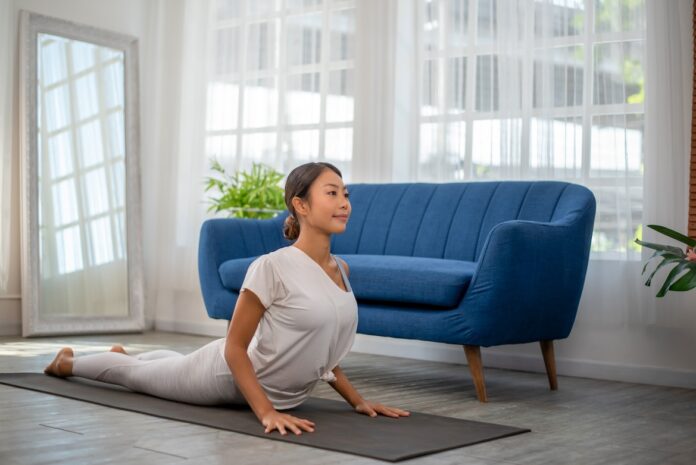When you’re within the midst of your 30s, experiencing gnawing decrease again ache is commonly taken as a truth of life. Whether or not you bent over to select a sock or your canine off the bottom, you’re sure to get up with aches the following day— or so the folklore goes.
This story isn’t fully unfaithful. In a 2019 survey performed by the Nationwide Middle for Well being Statistics, 39 p.c of adults reported experiencing again ache within the earlier three months. It was essentially the most prevalent web site for ache, and the variety of individuals coping with it solely elevated with age.
However there may be excellent news: Lumbar ache, particularly, is treatable and, oftentimes, preventable, says Grayson Wickham, PT, DPT, CSCS, a bodily therapist and the founding father of Motion Vault.
Forward, be taught extra concerning the potential causes behind your discomfort and the most effective stretches for lumbar ache.
What causes decrease again ache to start with?
Like all ache, decrease again ache is multifaceted and could also be attributed to a couple of trigger. Generally, lumbar ache is introduced on by sprains, strains, fractures, herniated discs, sciatica, traumatic damage, osteoarthritis, scoliosis, and lumbar spinal stenosis, in keeping with the American Affiliation of Neurological Surgeons.
In lots of circumstances, although, decrease again ache typically boils right down to a sedentary life-style, Wickham says. If you spend most of your time sitting in a chair along with your hips and knees bent at about 90 levels, your hip flexor and hamstring muscle tissues progressively adapt to this place and in the end shorten (learn: tighten), he explains.
By continually utilizing a backrest, your core musculature doesn’t have to work and, over time, weakens. So your potential to activate these muscle tissues whenever you want them—like whenever you’re lifting a heavy object—additionally declines, he says. Plus, the motion you do interact in could lack selection; you could be operating, strolling, or performing push-ups, squats, and lunges, actions that every one happen within the sagittal airplane of movement and neglect rotation or side-to-side motion.
In flip, you’ll be able to find yourself with a mix of poor core stability and activation, tight (and sometimes weak) hips and hamstrings, and tight, unstable joints that aren’t used to transferring in all planes of movement, Wickham says. Then, whenever you attain to the facet and attempt to decide a heavy field or your little one off the bottom, you lack the hip mobility and hamstring flexibility essential to get right into a secure beginning place and the core stability to guard your backbone.
“Now, one other joint has to compensate to your tight hips, and that is usually the low again,” Wickham says. “You’re mainly choosing up objects utilizing your low again in a rounded place, which is not an ideal place for the again for most individuals.” Cue: Decrease again ache and discomfort.
Decrease again ache may additionally be influenced by how you progress. People who fear about hurting their again could transfer with rigidity and stiffness all through their backbone, which may do extra hurt than good, says Andy Fata-Chan, PT, DPT, a bodily therapist and the founding father of Second Bodily Remedy and Efficiency in New York Metropolis.
“If we attempt to guard all the things, we attempt to preserve as a lot pressure as attainable, we find yourself transferring like robots, which isn’t sustainable,” he notes. “So we [as physical therapists] spend a variety of time unteaching that pressure by getting the backbone to maneuver via flexion, extension, facet to facet, [and] rotation.”
Equally, decrease again ache could develop if you happen to’re creating motion from one phase of your backbone somewhat than the complete construction, Fata-Chan says. When extending your again, as an example, the motion could stem solely from the lumbar backbone, growing stress on this space, somewhat than the lumbar, thoracic, and cervical sections.
Find out how to relieve decrease again ache
Engaged on sustaining wholesome posture and standing all through the day might help relieve and forestall decrease again ache. However often performing an lively stretching routine—an antidote to the shortage of various motion in your on a regular basis life—is essential, Wickham says.
At the start of the rehab course of, Wickham usually recommends muscle and fascia launch methods, concentrating on your glutes, obliques, and quadratus lumborum (a deep again muscle) to acutely lower ache. Then, he suggests transferring onto lively stretching and muscle activation workout routines that get to the basis reason behind your decrease again ache; concentrate on working to enhance hip and ankle mobility, core stability and activation, and the pliability and power of the hips, hamstrings, glutes, quads, adductors, and spinal erector muscle tissues via a full vary of movement.
Being dynamic along with your spinal motion all through the day and your stretch routine can also be essential, Fata-Chan says.
“If I preserve my again on this very impartial place, it is actually, actually powerful to really feel snug and relaxed since you’re not dynamic such as you usually needs to be,” he says. “I make the most of a variety of totally different [overhead or lateral] reaches in several angles so as to affect totally different elements of the spinal column.”
Think about treating your backbone to at least one rotation and one side-to-side motion and exploring flexion and extension, he provides.
TL;DR: “Discover two to 4 actions that really feel tight, a bit bit restricted, and simply preserve engaged on them every day till they really feel regular. Then, add them again into the routine as wanted,” Fata-Chan suggests.
The definitive finest stretches for lumbar ache
Strive a few of Wickham’s go-to stretches for lumbar ache, which he demonstrates beneath. Begin with the muscle and fascia launch methods to handle acute ache earlier than transferring on to a couple of the lively stretches and muscle activation workout routines, he recommends.
“It is essential with all of those lively stretches to get as deep into the stretch as attainable with out ache after which contract the stretched-out muscle tissues,” he notes.
Keep in mind to maneuver with management, and if you could modify any of the stretches for lumbar ache, lower your vary of movement.
“Take heed to your physique and have the ability to pull again if you could,” Fata-Chan says. “If you happen to transfer slowly, you’ll be able to discover it extra safely.”
1. Quadratus lumborum and indirect muscle and fascia launch
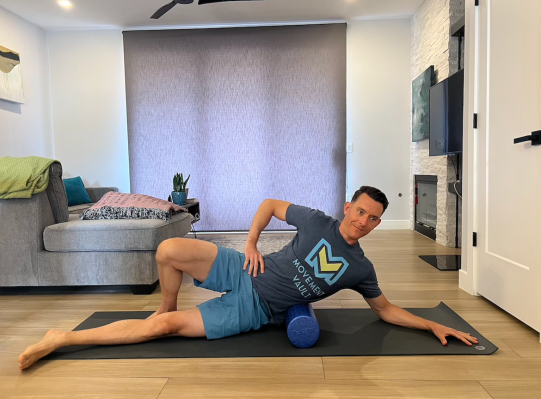
- Lie in your left facet with a foam curler positioned on the ground proper above your left hip.
- Begin along with your left leg totally prolonged on the ground, your proper leg bent at about 90 levels, and your proper foot positioned on the bottom.
- Place your proper hand in your hip and left elbow on the ground above your left shoulder, your forearm resting on the ground.
- Gently foam roll the complete space between the highest of your hips and your ribs, slowly transferring from the left facet of your physique to your again.
- Proceed for two minutes. Swap sides; repeat.
2. Gluteus muscle and fascia launch
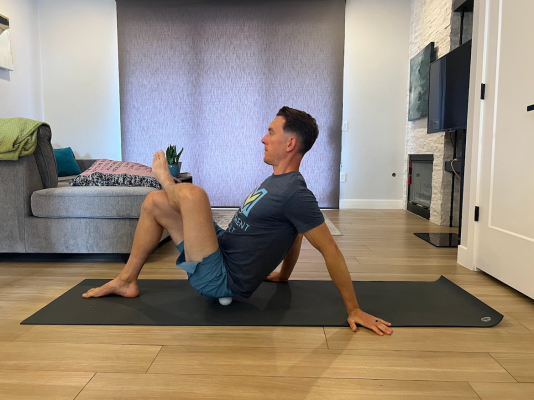
- Lie face up on the ground with a mobility ball positioned beneath your left glutes, your legs bent, and your ft resting on the bottom.
- Slowly transfer your leg inward and outward whereas mendacity on the ball.
- To progress, sit up along with your left leg crossed over your proper and your left ankle resting above your proper kneecap. Roll facet to facet till you discover a tender spot. Briefly pause earlier than persevering with to roll facet to facet.
- Proceed for two minutes. Swap sides; repeat.
3. Energetic hamstring stretch
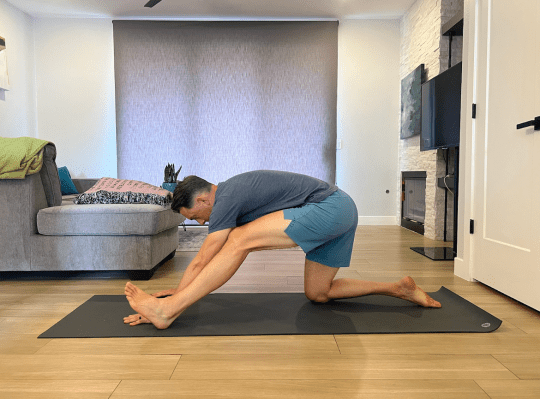
- Begin in a kneeling place on the ground along with your calves prolonged behind you and the tops of your ft resting on the bottom.
- Lengthen your left leg in entrance of you, your heel resting on the bottom and your toes pointing towards the ceiling.
- Hinge ahead on the hips to decrease your chest towards your thigh, inserting your fingers on the ground subsequent to your left leg.
- As soon as maximally stretched out, drive your heel downward, inflicting your hamstring muscle tissues to contract.
- Maintain this contraction for 20 seconds, then launch. That’s one rep.
- Do three 20-second holds per facet. Swap sides; repeat.
4. Energetic adductor stretch
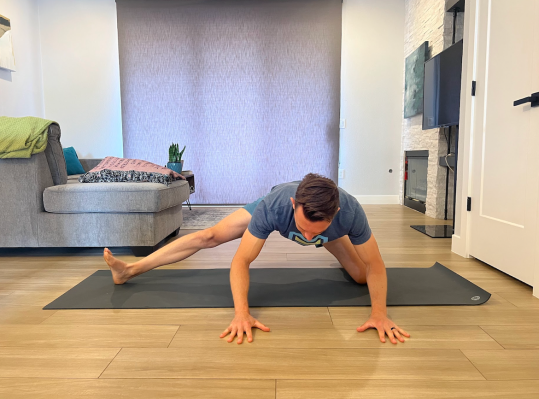
- Begin in a kneeling place on the ground along with your calves prolonged behind you and the tops of your ft resting on the bottom.
- Lengthen your proper leg out to the facet, your heel resting on the bottom and your toes pointing towards the ceiling.
- Hinge ahead on the hips till your again is in step with your hips, inserting your fingers on the bottom in entrance of your chest.
- As soon as maximally stretched out, drive your proper heel downward, inflicting your adductor muscle tissues to contract.
- Maintain this contraction for 20 seconds, then launch. That’s one rep.
- Do three 20-second holds per facet. Swap sides; repeat.
5. Energetic hip flexor stretch
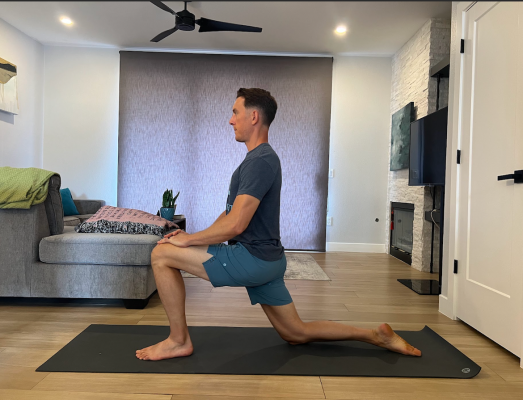
- Begin in a kneeling place on the ground along with your calves prolonged behind you and the tops of your ft resting on the bottom.
- Step your left foot onto the ground in entrance of you, bending your left knee to 90 levels. Relaxation your fingers gently in your left thigh.
- Protecting your shoulders and hips stacked, shift your weight into your entrance foot, feeling a stretch in your proper hip flexors.
- As soon as maximally stretched out, kick your proper foot into the bottom, inflicting your hip flexor muscle tissues to contract.
- Maintain this contraction for 20 seconds, then launch. That’s one rep.
- Do three 20-second holds per facet. Swap sides; repeat.
6. Inclined press-up
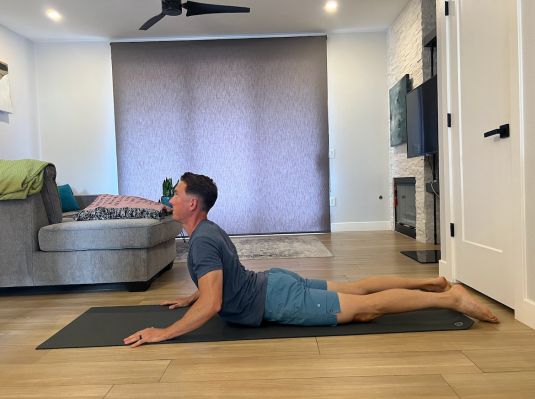
- Lie face-down on the ground along with your legs prolonged behind you, your elbows tucked into your sides, and palms on the bottom subsequent to your head.
- Gently urgent into your palms and lifting your chest, arch your again as a lot as attainable with out ache. Gaze ahead.
- Maintain this place. Contract your spinal erector muscle tissues that run on either side of your backbone to extend your arch for five seconds, then launch. That’s one rep.
- Do 10 5-second holds.
7. Cat-camel maintain (extension solely)
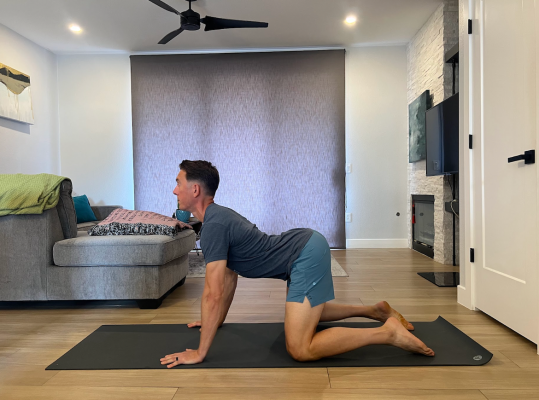
- Begin in a tabletop place on the ground along with your shoulders stacked along with your wrists and your hips stacked along with your knees. Gaze ahead.
- Protecting your chest lifted, arch your again as a lot as attainable with out ache.
- Maintain this place. Contract your spinal erector muscle tissues that run on either side of your backbone to extend your arch for five seconds, then launch. That’s one rep.
- Do 10 5-second holds.
8. Bridge maintain
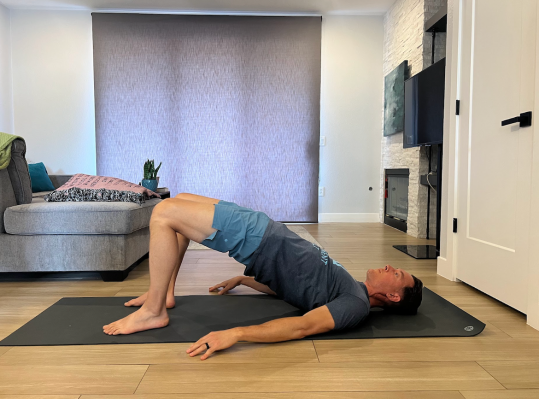
- Lie face-up on the ground along with your arms prolonged at your sides, your knees bent, and your ft planted on the bottom just a few inches in entrance of your glutes.
- Along with your core engaged, press via your heels to drive your hips towards the ceiling. Proceed driving your hips up till your physique varieties a straight line out of your knees to your chin.
- Maintain this place. Drive your ft into the bottom whereas barely dragging your heels towards your hips to contract your glutes for five seconds.
- Launch the contraction, then slowly decrease your hips again to the ground. That’s one rep.
- Do 10 5-second holds.
9. 90-90 lively stretch (entrance leg solely)
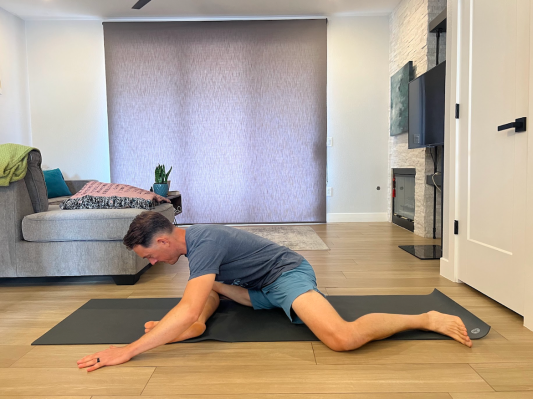
- Sit on the ground along with your proper leg bent at a roughly 90-degree angle in entrance of you, your proper knee in step with your proper hip. Lengthen your left leg out to the facet, bending your knee to about 90 levels so your left foot factors behind you.
- Protecting your again flat, hinge ahead on the hips, bringing your chest towards your proper leg. Place your fingers on the ground subsequent to your proper foot and knee.
- As soon as maximally stretched out, drive your proper calf down into the bottom, inflicting your hamstring muscle tissues to contract.
- Maintain this contraction for 20 seconds, then launch. That’s one rep.
- Do three 20-second holds per facet. Swap sides; repeat.
10. Full-range-of-motion hip activation
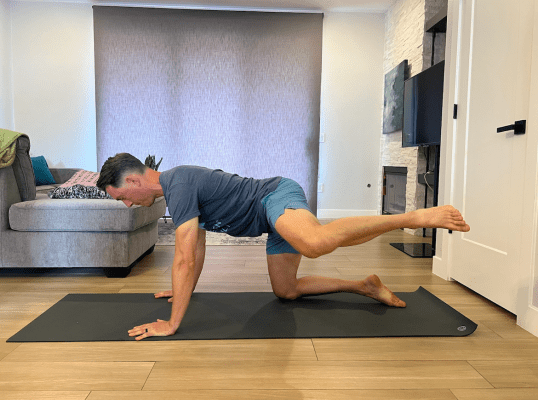
- Begin in a tabletop place on the ground along with your shoulders stacked along with your wrists and your hips stacked along with your knees. Have interaction your core and gaze on the flooring.
- Protecting your left knee bent and again flat, raise your left leg out the facet. Then, concentrate on making the largest pain-free hip circle attainable. All the movement needs to be coming out of your hip.
- Slowly make a hip circle in a single route, then the opposite. That’s one rep.
- Do 5 reps. Swap sides; repeat.
11. Facet bend maintain
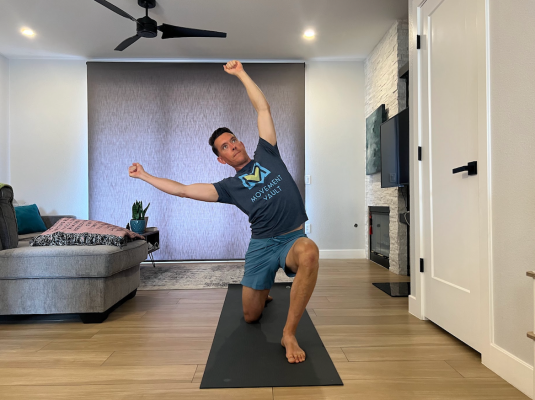
- Begin in a kneeling place on the ground along with your calves prolonged behind you and the tops of your ft resting on the bottom.
- Step your left foot onto the ground in entrance of you, bending your left knee to 90 levels. Lengthen your arms above your head.
- Protecting your hips and knees secure, bend via your backbone away from the painful facet. Contract the muscle tissues on the facet of your physique that you’re bending towards whereas your reverse arm punches up and over.
- Maintain this contraction for five seconds, then launch. That’s one rep.
- Do 10 5-second holds.
Security ideas to remember when performing stretches for lumbar ache
If any stretches you’re working towards for decrease again ache are exacerbating your signs, that individual motion both isn’t best for you at that second or you could modify it (assume: shortening your vary of movement), Wickham says.
You may expertise some muscle soreness after performing, say, a hip mobility train wherein you’re activating the glute muscle tissues. Nonetheless, “you by no means need to have elevated ache, elevated numbness, tingling, or burning through the train or proper after you carry out the train, in addition to inside a 24-hour interval after,” Wickham explains. In that case, take it as an indication to e-book an appointment along with your healthcare supplier.
FAQ
1. Is stretching good for lumbar ache?
Performing lively stretches that construct flexibility and power via a full vary of movement might help relieve ache within the lumbar backbone, also referred to as the decrease again. Be sure that to mix these actions with muscle and fascia launch methods to acutely lower ache.
Importantly, static stretching isn’t the reply to decrease again ache aid. “If you’re static stretching, aka passive stretching, you are primarily simply lengthening a muscle and stress-free and respiration into it,” Wickham says. “So that you’re really not bettering your muscle activation. You are not bettering joint stability [as you would with active stretching].”
It could really feel stress-free, however getting that activation, stability, and mobility as much as snuff is crucial to mitigating decrease again ache.
2. When do you have to not stretch with decrease again ache?
If you happen to expertise muscle weak point, numbness, burning, tingling, or a lack of sensation in your legs, skip the at-home stretch routine to your decrease again ache and meet along with your healthcare supplier, as chances are you’ll be coping with a disc bulge or herniation (like sciatica) affecting your nerves, in keeping with the specialists.
You’ll additionally need to get checked out by an expert in case you have a historical past of most cancers, you are waking up within the evening with ache, or you will have a fever—an indication you can have a spinal an infection, Fata-Chan provides.
3. What do you have to not do with decrease again ache?
Usually within the acute stage of decrease again ache, rotating via the backbone and bending to the facet could worsen signs, Wickham says. Nonetheless, sure ranges of movement could irritate your signs relying on the flavour of your decrease again ache. Some individuals could expertise worse discomfort throughout low again flexion (e.g., bending ahead), whereas low again extension (e.g. bending backward) can present aid, he says.
In case your ache is brought on by a disc bulge in your proper facet, bending to the proper can exacerbate signs on account of nerve compression whereas bending to the left can ease compression and supply aid, Wickham says. Keep away from any actions or stretches that worsen your ache and hunt down steering from a healthcare supplier if needed.

